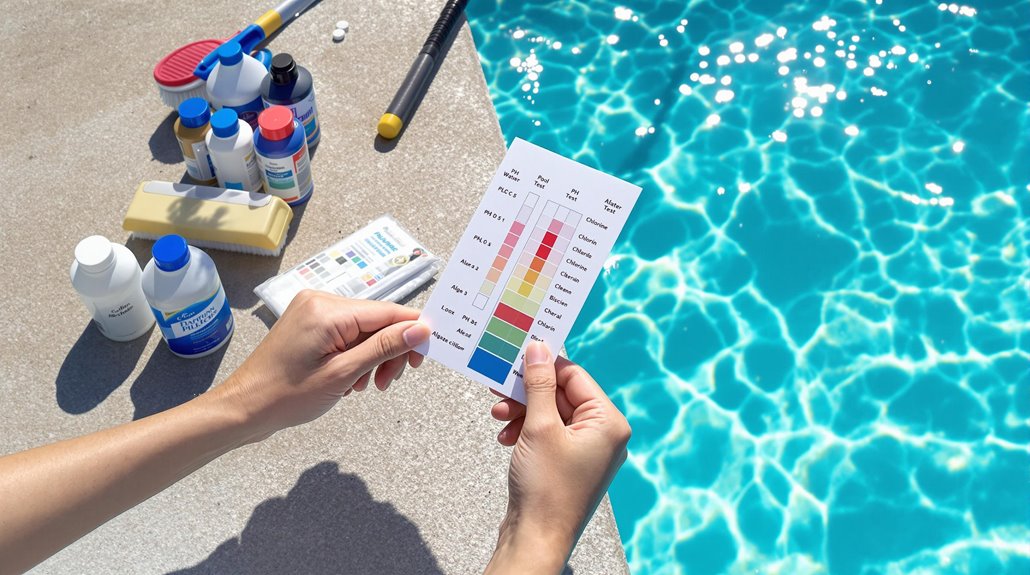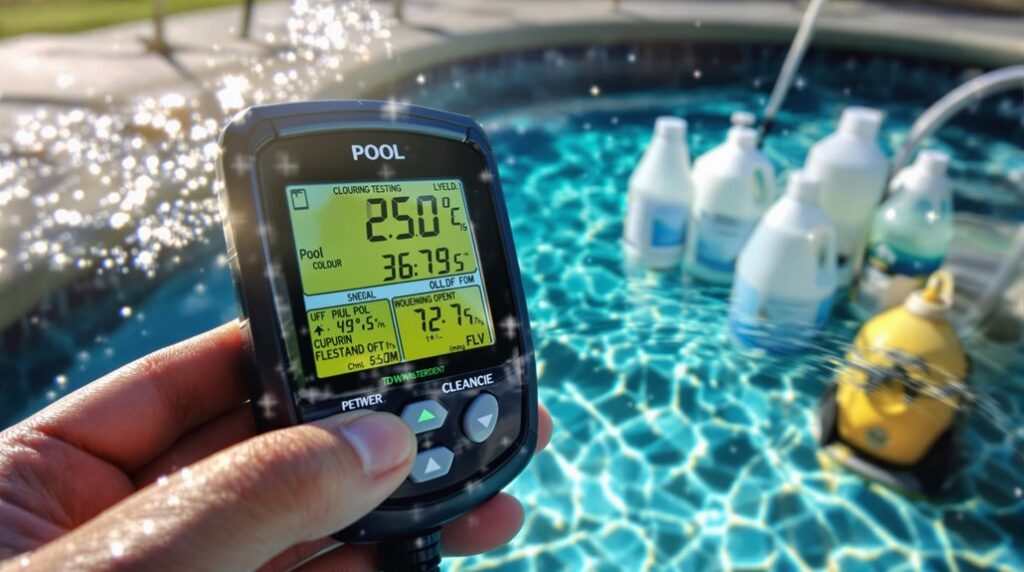Upon your pool failing a chemical test, start by collecting a fresh water sample from 12-18 inches below the surface and retest to confirm results. Use fresh reagents, holding bottles vertically for accuracy. Check chlorine levels initially (aim for 2-4 ppm), then pH (7.4-7.6), and total alkalinity (80-120 ppm). Clean your testing equipment and discard any expired or contaminated reagents. Understanding the common causes of failed tests will help you maintain consistently balanced pool chemistry.
Common Reasons for Failed Pool Tests

Two main categories of problems can cause your pool to fail a chemical test: testing equipment errors and reagent-related issues.
When conducting tests, you’ll get inaccurate readings if your vials are contaminated or if static charge builds up on reagent bottles. The way you handle your testing equipment matters as well – holding droppers at angles instead of vertically changes the amount of reagent dispensed. Different manufacturers’ dropper designs can also affect drop volumes noticeably. Timing is essential, especially for pH tests, which must be read within one minute of adding reagents. Pool pH balance is critical for maintaining safe and comfortable swimming conditions.
Your reagents themselves can compromise results if they’re expired or improperly stored. High chlorine levels above 10 ppm will bleach pH indicators, giving you falsely low readings. Using mismatched reagents from different test kits or adding algaecides can also interfere with accurate measurements. Cloudy pool water often indicates chemical imbalances that require careful testing and adjustment of sanitizer levels.
Understanding Chemical Test Results
Getting accurate chemical test results requires understanding the key parameters and their ideal ranges in your pool water. You’ll want to maintain pH between 7.4 and 7.6, free chlorine at 2.0-4.0 ppm, and total alkalinity between 80-120 ppm for optimal performance.
To get reliable readings, collect water samples from 12-18 inches below the surface, away from return jets. At the time of using test strips, hold them horizontally for 15 seconds before comparing colors. If you’re using liquid reagents, count drops precisely for accuracy. Always test chlorine levels initially, since high concentrations can interfere with pH readings. For cyanuric acid, which stabilizes chlorine against UV rays, you’ll only need monthly testing unless you’ve added new stabilizer. Keep CYA between 30-50 ppm to maintain effective sanitization.
Immediate Actions for Failed Tests

If your pool fails a chemical test, taking swift action is essential to prevent water quality issues from escalating. Start by retesting with a fresh sample to rule out any isolated results or environmental factors that might’ve affected your initial test.
When retesting, you’ll want to use fresh reagents and hold bottles vertically for accurate measurements. If you’re still getting concerning results, check your chemical levels systematically. Begin by measuring free chlorine, which should be between 1-3 ppm, then verify pH levels fall within 7.0-8.0. You can adjust these using stabilized chlorine or pH balancers as needed. Maintaining proper chemical balance is crucial for a sparkling clear pool. Don’t forget to check your reagents’ quality – discard any that are expired, frozen, or show signs of contamination such as cloudiness or discoloration. Regular year-round maintenance helps prevent most chemical imbalances from occurring in the first place.
Preventing Future Testing Problems
While consistent pool maintenance requires regular testing, preventing future problems starts with establishing proper testing protocols and habits. You’ll want to develop a systematic approach that guarantees accurate readings every time you test your pool water. Here’s what you need to focus on:
- Use high-quality test strips or kits that are known for reliability, since cheaper alternatives often lead to false readings.
- Always hold reagent droppers in a completely vertical position and crush tablets thoroughly before use.
- Test your water samples immediately after collection to prevent air and sunlight from affecting results.
- Keep your testing equipment clean, properly stored, and replace it according to manufacturer recommendations to maintain accuracy.
Proper pool filter maintenance helps ensure accurate water chemistry readings by removing contaminants that could skew test results.
Following these protocols will help you avoid testing errors and maintain better control over your pool’s chemistry.
Frequently Asked Questions
Can I Still Swim if Only One Chemical Test Parameter Fails?
No swimming if any chemical test fails. Imbalanced chemicals can irritate skin, eyes, and respiratory system.
How Often Should I Replace My Pool Testing Kit Components?
Replacement schedule:
- Reagents: 1-2 years
- Test strips: Annually
- Comparators: 2-3 years
- Replace sooner with heavy pool use
Do Weather Conditions Affect the Accuracy of Pool Chemical Tests?
Extreme temperatures, rain, and humidity compromise pool test accuracy by degrading reagents. Test during stable weather conditions.
Should I Retest Immediately if I Don’t Believe the Results?
Wait 30 minutes before retesting. Check test kit expiry date and ensure clean equipment.
Can Testing the Pool at Different Times of Day Yield Different Results?
Yes. Test in the morning after one hour of filtration for most accurate readings. UV light interferes with results.

